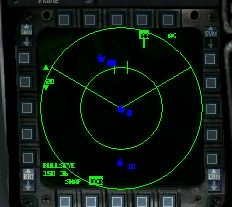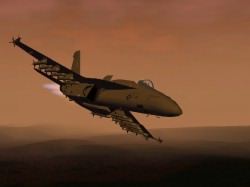| Hard Core Simulations: Live Long and Prosper
by Leonard "Viking1" Hjalmarson |
||||
|
Gimme My Action Game The third factor he has neglected is that game developers don't have to make clear marketing choices between SERIOUS on the one hand, and LIGHT or arcade on the other. In fact, the best serious simulations out there do not require any such choice on the part of the player.  Simplified Radar in Falcon4 Falcon 4, for example, while being an off-the-deep-end simulation much loved by the serious sim crowd, allows a host of options that can be selected by the casual sim pilot to enhance his survival and thus his fun. He can turn on invulnerability, choose a relaxed flight model, and simplified radar. He can turn on LABELS to show the ID of all all air and ground vehicles nearby. Targetting options can likewise be simplified, and enemy AI can be relaxed. Similarly, the casual pilot in European Air War or WW2 Fighters can choose a variety of parameters along which to ease the learning curve and enhance their victory. The genius of this system is twofold: first, it allows easy entry into a serious simulation for someone who wants to learn the ropes. Second, from the marketing perspective, it allows a product to span a huge range of appeal and thus increases the viability of a serious simulation. Development Cycle The fourth factor is Ty's assumption that the development cycle for a serious simulation is similar to that of Falcon 4, which exceeded four years. (I have to assume that he sees F4 as typical since he uses it as his primary example in comparison to Novalogic's F22 Lightning III.) In fact, F4's four year plus development cycle is NOT typical for a serious simulation. After surveying developers, the average development cycle is between 20 and 28 months. |
 Super Hornet Let's look at some examples. The time between M1TP2 and M1TP3 will be roughly two years. EF2000 was followed by TAW in less than two years. MiG Alley followed Flying Corps Gold in less than two years. Lesson? If the Falcon 4 team had not run into the incredible array of problems they encountered, we would now be playing Falcon 5.0 and the expense vs revenue figures for F4 would be more favorable. Finally, an unforeseen development will ease the transition into serious sims for some players this year. The online world is rapidly becoming an online community. I have in mind B17 II: The Mighty Eighth, by Wayward Design. This coming simulation is serious or "hard core" in every sense of the term. Yet the ability to populate a virtual B17 Flying Fortress with ten human players suddenly changes everything. It really won't matter if Joe Gunner in the tail turret can fly or navigate, but he can still participate in a hard core simulation! Genius. Signs of the Times This year's E3 in Los Angeles quelled my fears that the end of the world was near. Hard core simulation gaming is alive and well, and I think the situation may actually be IMPROVING rather than deteriorating. For example, how many simulations prior to 1998 actually modeled weather? In 1999 virtually every new simulation will do so, greatly increasing the level of challenge, in parallel to the real world of combat operations. Furthermore, as hardware capabilities increase, we are seeing more sophisticated AI and more powerful physics engines. Inevitably, it is becoming easier and easier for simulation developers to model real world interactions. But enough on details. For more on the climate of serious simulations see our May Editorial. Join a discussion forum on this article by clicking HERE.
|
|||
|
Copyright © 1997 - 2000 COMBATSIM.COM, INC. All Rights Reserved. Last Updated August 27th, 1999 |
||||
